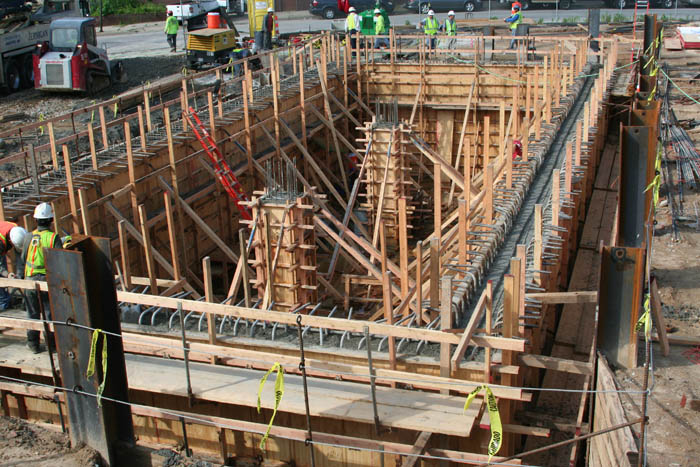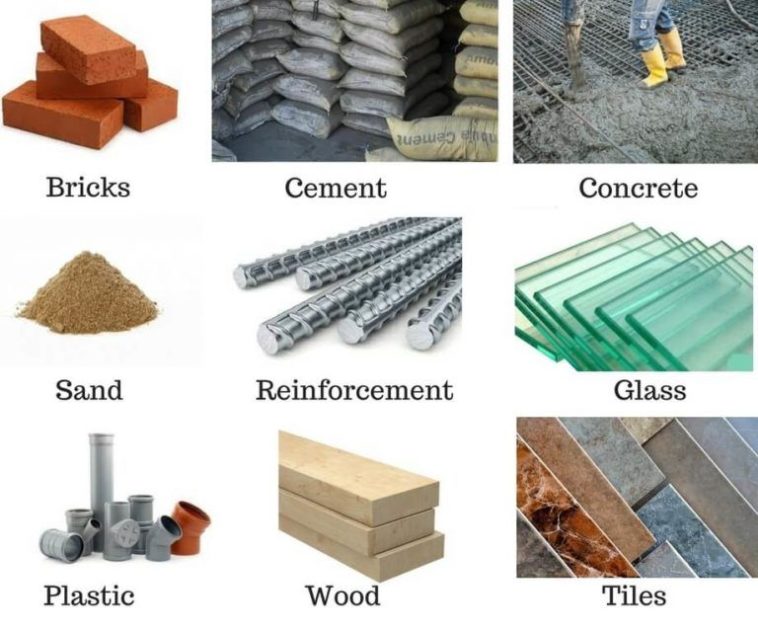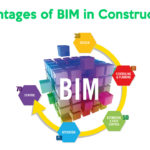In this post, we’re going to list of materials used in building construction. Building materials are basically divided into natural materials and synthetic materials.
Natural building material means. The materials made from natural products like clay, sand, and rocks are natural building materials.
Synthetic Building Material means. Building materials modified in industries. Materials that have gone through human processing is called synthetic building material. For example, plastics is a synthetic material.
There are many construction materials available on the market. Commonly, building materials are chosen based on personal preference, type of structure, and climate condition of the building location.
Let’s take a look at what are the materials used for house construction.
Concrete
Concrete is a construction material composed of cement, sand and coarse aggregates mixed with water that hardens over time.
Concrete uses in Floors, walls, and supports like column and slab construction.

Advantages
- High thermal mass
- Strong
- Durable
- Economical
- Resists termites and earthquakes
Disadvantages
- Production involves quarrying and creates greenhouse emissions;
- A poor insulator,
- It needs reinforcing.
Aluminium
Benefits of aluminum are Strong and lightweight material. And also it can be recycled.
Disadvantages Aluminum – Production is very energy-intensive and polluting.
Brick and Block
Brick is one of the most used materials for house construction. It used to make walls, pavements and other elements in masonry construction.
Advantages – Versatile, good thermal mass
Disadvantages – Production is energy-intensive and uses non-renewable resources.
Glass
Glass let to light into an area. It can also be used to add decorative effects. There are different types of glass in a range of patterns and tints. Generally uses for Windows, doors, and skylights.
Advantages – Stable, long-lasting, efficient, recyclable
Disadvantages – Production is energy-intensive, uses non- renewable minerals.
Fibre cement sheeting
Fibre cement is a composite building and construction material, used mainly in roofing and facade products because of its strength and durability.
Advantages – Low embodied energy, light, inexpensive, good thermal properties, can be rendered
Disadvantages – Not as strong as some other options; associated with cheap housing and asbestos.
Ceramics
Ceramics is used for finishing work. you can see ceramics finishes floors, walls, counter-tops, and ceilings.
Plasterboard
Plasterboard is a panel made of gypsum usually pressed between a facer and a backer. It is used to make interior walls and ceilings. This ‘Drywall’ construction became popular as a quicker alternative to traditional lath and plaster.
Plasterboard is used to help builders and designers meet building regulations for fire protection, acoustic insulation and thermal efficiency.
Metal
Metal is used as a structural framework for larger buildings like skyscrapers. Metals are used because it is long lasting There are different types of metals you can use for
The strengths lie in:
Flexibility and resilience – Highly durable and strong
Weatherproof – Can withstand adverse climatic conditions to a great extent
Fire resistant – less prone to burning, compared to wood or glass
Its disadvantages include:
- Prone to rust – and consequently affects the structural integrity of the construction
- Difficult to seal – inconvenient to design
- Expensive – metal constructions are highly expensive. Also, they require high maintenance
Wood
Wood is a product of trees that used for construction purposes when cutting or pressed into lumber and timber, such as boards, planks, and similar materials. Uses – Floors, walls, supports and roof frames.
Advantages – Strong, easy to work with, versatile, potentially renewable, biodegradable
Disadvantages – Some timber is non-renewable; often treated with toxic chemicals.
Rock
Rock is one building material that has been used in building structures for centuries. It is also in fact, one of the longest lasting building materials available.
Mostly stone buildings can be seen in most major cities, some civilizations built entirely with stone such as the Pyramids in Egypt
Plastics
Plastics are used in a growing range of building including insulation, piping, window frames, and interior design. It’s light, durable, and resistant to damp.



